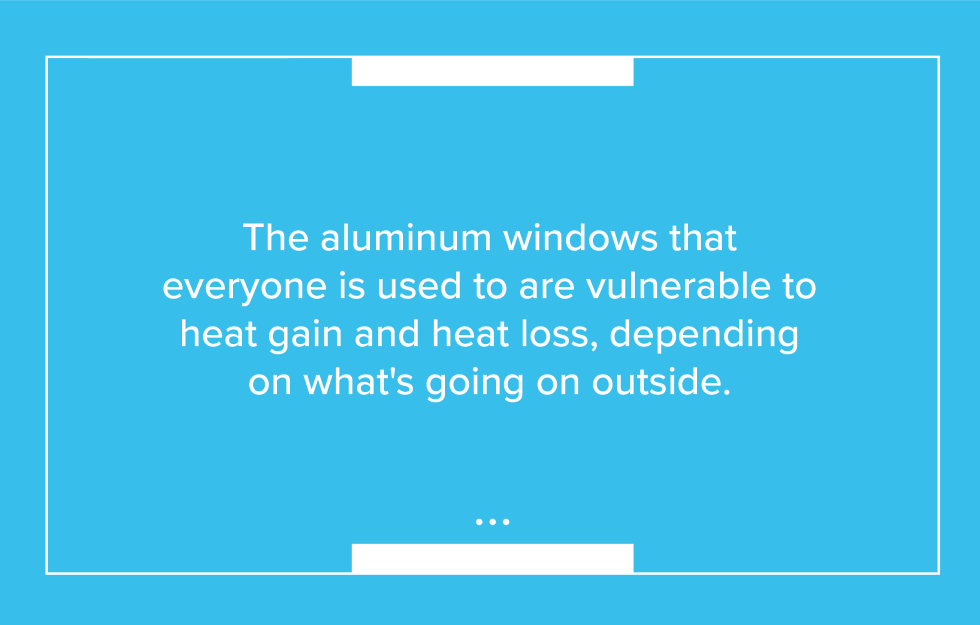When it comes to windows, it’s not always all about glass. The frame also has an impact on how much energy you can save. Even sound can behave differently depending on the type of frame that your windows have. As great as aluminum is on windows, there’s one weakness that can present a variety of problems for your home.
For instance, it doesn’t really do a good job of hanging onto heat. To solve this issue, you may consider something called thermally broken windows. Below is a guide that’ll help you understand the difference between thermally broken windows vs non thermally broken ones. Keep reading to find out more.

What are Thermally Broken Windows?
When we speak of a thermal break, think of a protective border between the outside part of the window frame and the inside. This specially-made insulator helps to make sure that even when the external part of the frame is freezing, the internal part won’t. It stops condensation and thin ice from piling up on the inside and even the furniture and upholstery will be defended from dampness.
The word break has nothing to do with something getting damaged. It simply refers to the separation or a space between the two pieces of metal in the frame. The thermal aspect has to do with the temperature-balancing nature of the ‘break.’ This is an innovation that arose from the need to have a better insulation solution for metallic windows in homes, and that’s the whole idea.

Do Thermally Broken Aluminum Windows Suit your Home?
If temperature control is something that’s important to you, then you should definitely consider thermally broken windows. Installing thermally broken windows will help to ensure that there isn’t an exchange of cold air from the outside in wintery conditions. In warmer climates, your windows won’t be sweating since the heated exterior won’t come into direct contact with the interior part of the frame.
If your home is situated in a moisture-in-the-floorboards kind of an area, getting thermally broken aluminum windows is your number one option. Even your lifestyle will contribute to whether or not you need to go for thermally broken windows in your home. If you’ve got a Jacuzzi, an indoor sauna, or an indoor pool, you might want to consider the thermal breaking solution.
Thermally Broken Windows vs Non-Thermally Broken
Windows with a thermal break can help to keep heat and noise conduction at a lower rate. The heat-resistant properties are so great that even flames will do no harm, which can’t be said of non thermally broken windows. You get an added layer of defense while cutting down on maintenance even more, even though standard aluminum windows already rank better than other kinds when it comes to being easy to clean.

Your windows get to last longer and you won’t have to worry about corrosion either. Windows without a thermal break, on the other hand, can expose your home to the elements; resulting in a lower level of comfortability than what you would get with windows that have the break. Some people may see it as a luxury, but that’s only because they don’t think about the implications it has.
How well your windows do depends on how well they can adapt to the change in the surroundings. The aluminum windows that everyone is used to are vulnerable to heat gain and heat loss, depending on what’s going on outside. A solid metal frame is not enough to stop the transfer of heat and cold, so you need proper insulation so your energy bill won’t skyrocket.
A Question of Performance
In order to determine window performance, we have to look at something called u-values. Higher u-values mean better performance while lower u-values translate to poor performance. There are three values to be considered here; with each one tracking how well the glass and the frame perform as well as the thermal capabilities of the overall installation. The last of the three is the one that you should consider the most.
When all u-values of thermally broken and non-broken aluminum windows are taken into account, it’s clear that the former is superior to the latter. What’s more, there are fewer code compliance issues with the thermal break.
Since glaziers know that most homeowners are unfamiliar with building regulations, they may try to sell you a framing system that isn’t up to standard. The best way to avoid this is by sourcing the performance data of the product straight from the manufacturer.
What’s the Secret?
Since thermal breaks are made from synthetic plastic or fabric, this helps to address aluminum’s high conductance. If you think that plastic or fabric is not tough enough, just know that we’re not talking about the sweet wrapper kind of plastic and the t-shirt kind of fabric. This stuff is tough, as it’s specially designed by scientists to withstand the elements and as a result, the cold air from the outdoors cannot affect the warm air inside.
A normal aluminum window will have nothing but a solid one-piece metal frame separating two glass units. A thermally broken window, however, will have a thermal insulator with metal half-shells surrounding it on both sides. This makes for a stronger framework.
Think about having multiple walls in front of each other. The more walls you have, the easier it is to keep something in or out. Now think about adding an inner layer within each wall that makes it even easier to keep something in or out. It’s the same idea with window frames; a core layer reinforces the structural integrity of the entire aluminum shell, which serves as an outer layer or the skin.
You want a stable window structure that will never change in any way. We know other kinds of frames are capable of expanding when it’s hot, for example, but that’s not exactly ideal. A fortified frame will do you the most good. After all, the frame is what holds the panes of a window in place, and it’s what keeps the glass stuck to the building. From light, to sound, and air; the frame is responsible for keeping it all in check.
Aluminum frames are known to be the least energy efficient out of all the different kinds of frames. They don’t even last that long because salty water in the air can eat away at the material. This is why thermal breaks are so necessary for anyone trying to get the stylish, modern look of aluminum windows without sacrificing durability.
It’s all about reducing air infiltration to a non-existent level at will, and we now know that thermal breaks can help to achieve that. Metal frames are one of the more reasonable choices one can go for when it comes to windows, considering their affordability. It almost makes it even more necessary for one to make sure that their windows are functioning optimally and that changes are made for the sake of enhancing energy and cost-efficiency.

Now, it’s not only the type of glass that makes an impact. You need the right combination of glass and frame. Aluminum frames are slimmer than most and while they may be a fashionable look for a home, it does leave room for a lot to get through. Adding a thermal break is a great way to make the frame thicker and more durable.
Stand your Ground
Confusion is often used as a sales tactic, and most salespeople will throw big words at you to stun you like a deer in headlights. If they start talking about the different u-values, tell them you’re only interested in the Uw value and if the frame doesn’t have a Uw value of 1.5, then you should look elsewhere.
The Right Choice
If you’ve made it this far, then you have all the information you need to find the ultimate window solution. You have an idea about how it works, and you know how to go about it. All that’s left is for you to set it all in motion.
Unless you want to keep replacing your aluminum windows, you’ve got to go with the thermal break. It’s your best chance at enjoying the benefits of aluminum windows for as long as you possibly can.
Understanding the differences between thermally broken windows and non-thermally broken windows should help you make the right design choice for your home. Since you’re now aware that your decision will affect everything from your finances to your level of comfort, you probably get just how big of a deal the whole thermal break thing is. Thermally broken windows are a rewarding investment worth making as soon as possible.
Got a Hankering for More Awesome Demers Glass content? Check out our piece on Pella vs Andersen Windows here.
